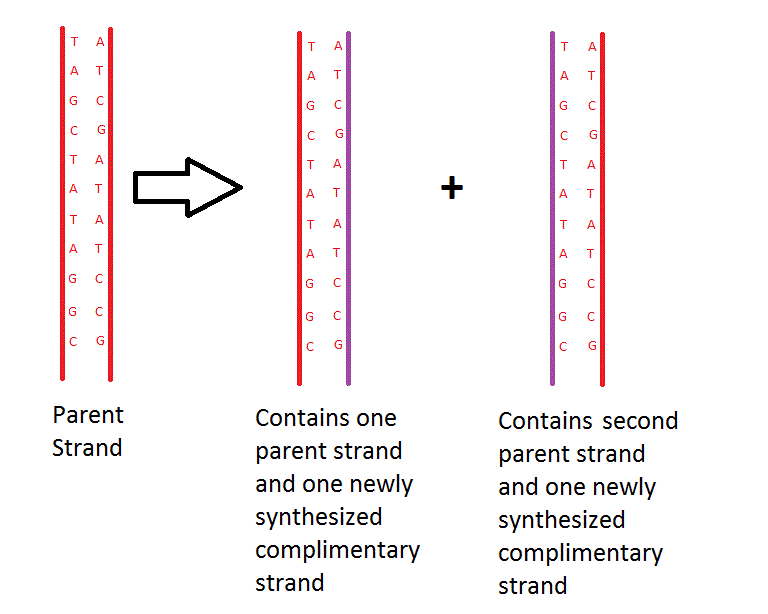Semi-conservative replication: Difference between revisions
No edit summary |
m corrected referencing format |
||
| Line 1: | Line 1: | ||
Semi-conservative replication is the mechanism by which [[DNA|DNA]] replicates in [[Cell|cells]]. The parent strand splits in two and uses itself as a template to form a second [[Complementary strand|complementary strand]]. The exposed bases on the single-stranded DNA complementary base pair to [[Nucleotides|nucleotides]]. A ([[Adenine|Adenine]]) pairs with T ([[Thymine|Thymine]]) and C ([[Cytosine|Cytosine]]) pairs with G ([[Guanine|Guanine]]) | Semi-conservative replication is the mechanism by which [[DNA|DNA]] replicates in [[Cell|cells]]. The parent strand splits in two and uses itself as a template to form a second [[Complementary strand|complementary strand]]. The exposed bases on the single-stranded DNA complementary base pair to [[Nucleotides|nucleotides]]. A ([[Adenine|Adenine]]) pairs with T ([[Thymine|Thymine]]) and C ([[Cytosine|Cytosine]]) pairs with G ([[Guanine|Guanine]])<ref>Alberts et al. Molecular biology of the cell fifth edition 2007. Page 266</ref>. Together the template strand and the complementary strand bond together to form a new double strand of DNA. One parent double strand of DNA will thus become two daughter double strands of DNA<ref>Hartl, D and Jones, E (2009). Genetics- Analysis of genes and genomes. 7th ed. Sudbury: Jones and Bartlett Publishers, Inc. 192.</ref>. | ||
The new strand of [[DNA|DNA]] is made in the 5' to 3' direction as a deoxyribonucleotide is added to the 3' OH end of the chain which is catalysed by [[DNA polymerase|DNA polymerase]] | The new strand of [[DNA|DNA]] is made in the 5' to 3' direction as a deoxyribonucleotide is added to the 3' OH end of the chain which is catalysed by [[DNA polymerase|DNA polymerase]]<ref>Alberts et al. Molecular biology of the cell fifth edition, 2007. Page 268</ref>. | ||
The term "semi-conservative" refers to the fact that each of daughter double | The term "semi-conservative" refers to the fact that each of the daughter double helixes contains one conserved strand from the parent DNA, as well as one newly synthesised strand<ref>http://www.nature.com/scitable/topicpage/Semi-Conservative-DNA-Replication-Meselson-and-Stahl-421</ref>.[[Image:Semi-conservative replication.gif]] | ||
=== References === | === References === | ||
<references /> | <references /> | ||
Revision as of 14:22, 2 December 2018
Semi-conservative replication is the mechanism by which DNA replicates in cells. The parent strand splits in two and uses itself as a template to form a second complementary strand. The exposed bases on the single-stranded DNA complementary base pair to nucleotides. A (Adenine) pairs with T (Thymine) and C (Cytosine) pairs with G (Guanine)[1]. Together the template strand and the complementary strand bond together to form a new double strand of DNA. One parent double strand of DNA will thus become two daughter double strands of DNA[2].
The new strand of DNA is made in the 5' to 3' direction as a deoxyribonucleotide is added to the 3' OH end of the chain which is catalysed by DNA polymerase[3].
The term "semi-conservative" refers to the fact that each of the daughter double helixes contains one conserved strand from the parent DNA, as well as one newly synthesised strand[4].
References
- ↑ Alberts et al. Molecular biology of the cell fifth edition 2007. Page 266
- ↑ Hartl, D and Jones, E (2009). Genetics- Analysis of genes and genomes. 7th ed. Sudbury: Jones and Bartlett Publishers, Inc. 192.
- ↑ Alberts et al. Molecular biology of the cell fifth edition, 2007. Page 268
- ↑ http://www.nature.com/scitable/topicpage/Semi-Conservative-DNA-Replication-Meselson-and-Stahl-421